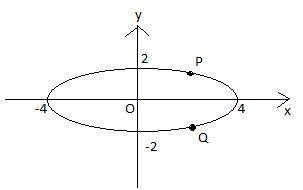
If $P(2,k)$ and $Q(2,-k)$ are points on the curve $\dfrac{{{x}^{2}}}{16}+\dfrac{{{y}^{2}}}{4}=1$. Find the value of $k$.


Answer
582.9k+ views
Hint: Substitute the value of either of the points given in the equation of the ellipse. Solve the quadratic equation to get the value of $k$. Remember that $k$ will have both positive and negative value but we have to consider only positive value because the points are lying in the 1st and 4th quadrant, so in 1st quadrant coordinates must be positive.
Complete step-by-step solution -

It is given that the points $P(2,k)$ and $Q(2,-k)$ lie on the elliptic curve given by: $\dfrac{{{x}^{2}}}{16}+\dfrac{{{y}^{2}}}{4}=1$. That means the two given points will satisfy the equation of the curve. Therefore, substituting the coordinate of $P(2,k)$ in the equation of ellipse, we get,
$\begin{align}
& \dfrac{{{2}^{2}}}{16}+\dfrac{{{k}^{2}}}{4}=1 \\
& \Rightarrow \dfrac{4}{16}+\dfrac{{{k}^{2}}}{4}=1 \\
& \Rightarrow \dfrac{1}{4}+\dfrac{{{k}^{2}}}{4}=1 \\
\end{align}$
Taking L.C.M we get,
$\Rightarrow \dfrac{{{k}^{2}}+1}{4}=1$
By cross-multiplication we have,
$\begin{align}
& \Rightarrow {{k}^{2}}+1=4 \\
& \Rightarrow {{k}^{2}}=3 \\
\end{align}$
Taking square root we get,
$k=\pm \sqrt{3}$
Now, we have two values of $k$, one positive and the other negative. But we can see that point $P(2,k)$ lies in the first quadrant and we know that in the 1st quadrant the coordinates of a point is positive. Therefore, $k$ must be positive.
Hence, $k=\sqrt{3}$.
Note: One may note that we can also substitute the point $Q(2,-k)$ in the equation of the curve. This will not change the answer because the same equation will be formed in terms of $k$. Here also we have to consider the positive value of $k$ because there is already a minus sign present in the point $Q(2,-k)$. Since, this point lies in the fourth quadrant therefore $y-\text{coordinate}$ must be negative. This will happen only when we will consider only the positive value of $k$.
Complete step-by-step solution -

It is given that the points $P(2,k)$ and $Q(2,-k)$ lie on the elliptic curve given by: $\dfrac{{{x}^{2}}}{16}+\dfrac{{{y}^{2}}}{4}=1$. That means the two given points will satisfy the equation of the curve. Therefore, substituting the coordinate of $P(2,k)$ in the equation of ellipse, we get,
$\begin{align}
& \dfrac{{{2}^{2}}}{16}+\dfrac{{{k}^{2}}}{4}=1 \\
& \Rightarrow \dfrac{4}{16}+\dfrac{{{k}^{2}}}{4}=1 \\
& \Rightarrow \dfrac{1}{4}+\dfrac{{{k}^{2}}}{4}=1 \\
\end{align}$
Taking L.C.M we get,
$\Rightarrow \dfrac{{{k}^{2}}+1}{4}=1$
By cross-multiplication we have,
$\begin{align}
& \Rightarrow {{k}^{2}}+1=4 \\
& \Rightarrow {{k}^{2}}=3 \\
\end{align}$
Taking square root we get,
$k=\pm \sqrt{3}$
Now, we have two values of $k$, one positive and the other negative. But we can see that point $P(2,k)$ lies in the first quadrant and we know that in the 1st quadrant the coordinates of a point is positive. Therefore, $k$ must be positive.
Hence, $k=\sqrt{3}$.
Note: One may note that we can also substitute the point $Q(2,-k)$ in the equation of the curve. This will not change the answer because the same equation will be formed in terms of $k$. Here also we have to consider the positive value of $k$ because there is already a minus sign present in the point $Q(2,-k)$. Since, this point lies in the fourth quadrant therefore $y-\text{coordinate}$ must be negative. This will happen only when we will consider only the positive value of $k$.
Recently Updated Pages
ABCD is a parallelogram The position vectors of the class 10 maths CBSE

How do you evaluate log dfrac16left dfrac136 right class 10 maths CBSE

The first Indian to enter the Indian Civil Service class 10 social science CBSE

What is the value of 1kWh equal to A36 times 106MJ class 10 physics CBSE

How do you find the median of 4 numbers class 10 maths CBSE

A right triangle has a hypotenuse of length p cm and class 10 maths CBSE

Trending doubts
Why is there a time difference of about 5 hours between class 10 social science CBSE

Tropical deciduous trees shed their leaves in the dry class 10 social science CBSE

The Equation xxx + 2 is Satisfied when x is Equal to Class 10 Maths

Write a letter to the principal requesting him to grant class 10 english CBSE

The uses of bleaching powder are A It is used bleaching class 10 chemistry CBSE

Leap year has days A 365 B 366 C 367 D 368 class 10 maths CBSE




